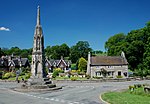River Manifold

The River Manifold is a river in Staffordshire, England. It is a tributary of the River Dove (which also flows through the Peak District, forming the boundary between Derbyshire and Staffordshire). The Manifold rises at Flash Head just south of Buxton near Axe Edge, at the northern edge of the White Peak, known for its limestone beds. It continues for 12 miles (19 km) before it joins the Dove. For part of its course, it runs underground (except when in spate), from Wetton Mill to Ilam. During this section it is joined by its major tributary, the River Hamps. Villages on the river include Longnor, Hulme End and Ilam. Its name may come from Anglo-Saxon manig-fald = "many folds", referring to its meanders.
Excerpt from the Wikipedia article River Manifold (License: CC BY-SA 3.0, Authors, Images).River Manifold
Malecon 2000, Guayaquil Centro (Rocafuerte)
Geographical coordinates (GPS) Address Nearby Places Show on map
Geographical coordinates (GPS)
| Latitude | Longitude |
|---|---|
| N 53.05 ° | E -1.7847222222222 ° |
Address
Monumento "Elemento Tierra"
Malecon 2000
090307 Guayaquil, Centro (Rocafuerte)
Guayas, Ecuador
Open on Google Maps







